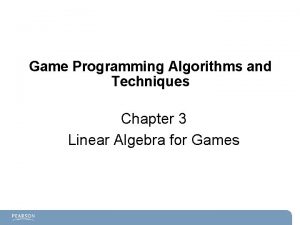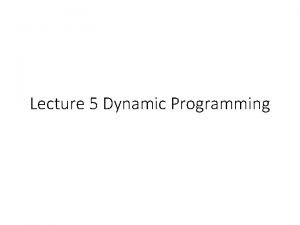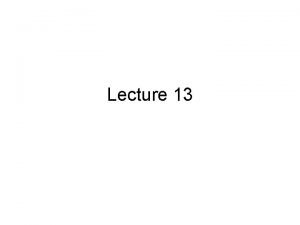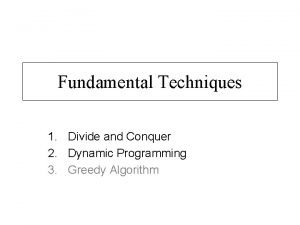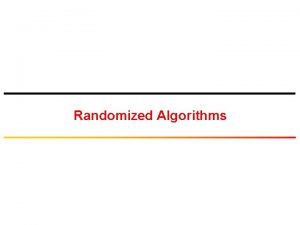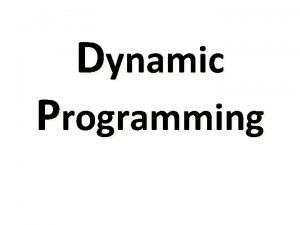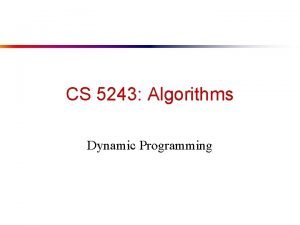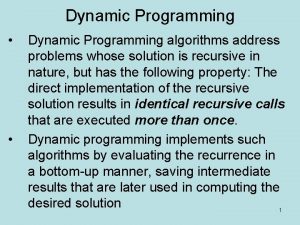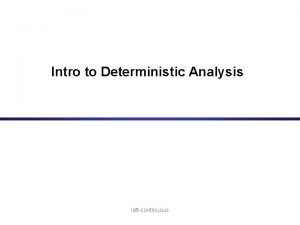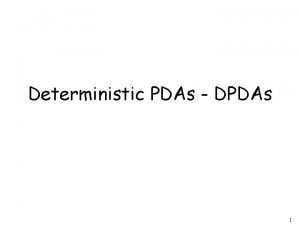Deterministic counting algorithms Counting via dynamic programming not
![Deterministic counting algorithms Counting via dynamic programming [not in the book]: - e. g. Deterministic counting algorithms Counting via dynamic programming [not in the book]: - e. g.](https://slidetodoc.com/presentation_image/660dcf7392f48bec857408fc1c9b1578/image-1.jpg)
![Deterministic counting algorithms Counting via dynamic programming [not in the book]: - e. g. Deterministic counting algorithms Counting via dynamic programming [not in the book]: - e. g.](https://slidetodoc.com/presentation_image/660dcf7392f48bec857408fc1c9b1578/image-2.jpg)
![From counting to sampling [Chapter 1] Sampling increasing subsequences uniformly at random ? From counting to sampling [Chapter 1] Sampling increasing subsequences uniformly at random ?](https://slidetodoc.com/presentation_image/660dcf7392f48bec857408fc1c9b1578/image-3.jpg)
![Perfect matchings in planar graphs Counting problem definition: [Section 1. 2] Perfect matchings in planar graphs Counting problem definition: [Section 1. 2]](https://slidetodoc.com/presentation_image/660dcf7392f48bec857408fc1c9b1578/image-4.jpg)

![Perfect matchings in planar graphs [Section 1. 2] Def: Let G be an orientation Perfect matchings in planar graphs [Section 1. 2] Def: Let G be an orientation](https://slidetodoc.com/presentation_image/660dcf7392f48bec857408fc1c9b1578/image-6.jpg)
![Perfect matchings in planar graphs [Section 1. 2] Def: Skew adjacency matrix of G Perfect matchings in planar graphs [Section 1. 2] Def: Skew adjacency matrix of G](https://slidetodoc.com/presentation_image/660dcf7392f48bec857408fc1c9b1578/image-7.jpg)
![Perfect matchings in planar graphs [Section 1. 2] Thm 1. 11 Kasteleyn): ( For Perfect matchings in planar graphs [Section 1. 2] Thm 1. 11 Kasteleyn): ( For](https://slidetodoc.com/presentation_image/660dcf7392f48bec857408fc1c9b1578/image-8.jpg)
![Determinants, etc. [Section 1. 2] Def: The determinant of an nxn matrix A is: Determinants, etc. [Section 1. 2] Def: The determinant of an nxn matrix A is:](https://slidetodoc.com/presentation_image/660dcf7392f48bec857408fc1c9b1578/image-9.jpg)
![Determinants, etc. [Section 1. 2] Def: The permanent of an nxn matrix A is: Determinants, etc. [Section 1. 2] Def: The permanent of an nxn matrix A is:](https://slidetodoc.com/presentation_image/660dcf7392f48bec857408fc1c9b1578/image-10.jpg)

![Pfaffian orientations in planar graphs [Section 1. 2] Lemma 1. 13: Let G be Pfaffian orientations in planar graphs [Section 1. 2] Lemma 1. 13: Let G be](https://slidetodoc.com/presentation_image/660dcf7392f48bec857408fc1c9b1578/image-12.jpg)
![Pfaffian orientations in planar graphs [Section 1. 2] Lemma 1. 13: Let G be Pfaffian orientations in planar graphs [Section 1. 2] Lemma 1. 13: Let G be](https://slidetodoc.com/presentation_image/660dcf7392f48bec857408fc1c9b1578/image-13.jpg)
![Pfaffian orientations in planar graphs [Section 1. 2] Thm 1. 14: Every planar graph Pfaffian orientations in planar graphs [Section 1. 2] Thm 1. 14: Every planar graph](https://slidetodoc.com/presentation_image/660dcf7392f48bec857408fc1c9b1578/image-14.jpg)

- Slides: 15
![Deterministic counting algorithms Counting via dynamic programming not in the book e g Deterministic counting algorithms Counting via dynamic programming [not in the book]: - e. g.](https://slidetodoc.com/presentation_image/660dcf7392f48bec857408fc1c9b1578/image-1.jpg)
Deterministic counting algorithms Counting via dynamic programming [not in the book]: - e. g. , counting the number of increasing subsequences [Chapter 1]
![Deterministic counting algorithms Counting via dynamic programming not in the book e g Deterministic counting algorithms Counting via dynamic programming [not in the book]: - e. g.](https://slidetodoc.com/presentation_image/660dcf7392f48bec857408fc1c9b1578/image-2.jpg)
Deterministic counting algorithms Counting via dynamic programming [not in the book]: - e. g. , counting the number of increasing subsequences [Chapter 1]
![From counting to sampling Chapter 1 Sampling increasing subsequences uniformly at random From counting to sampling [Chapter 1] Sampling increasing subsequences uniformly at random ?](https://slidetodoc.com/presentation_image/660dcf7392f48bec857408fc1c9b1578/image-3.jpg)
From counting to sampling [Chapter 1] Sampling increasing subsequences uniformly at random ?
![Perfect matchings in planar graphs Counting problem definition Section 1 2 Perfect matchings in planar graphs Counting problem definition: [Section 1. 2]](https://slidetodoc.com/presentation_image/660dcf7392f48bec857408fc1c9b1578/image-4.jpg)
Perfect matchings in planar graphs Counting problem definition: [Section 1. 2]

Perfect matchings in planar graphs Let M, M’ be two perfect matchings. What does M [ M’ look like ? [Section 1. 2]
![Perfect matchings in planar graphs Section 1 2 Def Let G be an orientation Perfect matchings in planar graphs [Section 1. 2] Def: Let G be an orientation](https://slidetodoc.com/presentation_image/660dcf7392f48bec857408fc1c9b1578/image-6.jpg)
Perfect matchings in planar graphs [Section 1. 2] Def: Let G be an orientation of G and let C be an even cycle of G. C is oddly oriented by G if an odd # of edges in C disagrees with G. G is Pfaffian if, for every perfect matchings M, M’, every cycle in M [ M’ is oddly oriented. Note: not every cycle in G, just every cycle in M [ M’.
![Perfect matchings in planar graphs Section 1 2 Def Skew adjacency matrix of G Perfect matchings in planar graphs [Section 1. 2] Def: Skew adjacency matrix of G](https://slidetodoc.com/presentation_image/660dcf7392f48bec857408fc1c9b1578/image-7.jpg)
Perfect matchings in planar graphs [Section 1. 2] Def: Skew adjacency matrix of G is As(G ) where aij = +1 if (i, j) is an edge in G -1 if (j, i) is an edge in G 0 otherwise
![Perfect matchings in planar graphs Section 1 2 Thm 1 11 Kasteleyn For Perfect matchings in planar graphs [Section 1. 2] Thm 1. 11 Kasteleyn): ( For](https://slidetodoc.com/presentation_image/660dcf7392f48bec857408fc1c9b1578/image-8.jpg)
Perfect matchings in planar graphs [Section 1. 2] Thm 1. 11 Kasteleyn): ( For any Pfaffian orientation G , # perfect matchings of G = det As(G ) Thm 1. 14: Every planar graph has a Pfaffian orientation (and it can be easily constructed). Note: It is not known whether the problem of deciding if a graph has a Pfaffian orientation is in P nor whether it is NPcomplete.
![Determinants etc Section 1 2 Def The determinant of an nxn matrix A is Determinants, etc. [Section 1. 2] Def: The determinant of an nxn matrix A is:](https://slidetodoc.com/presentation_image/660dcf7392f48bec857408fc1c9b1578/image-9.jpg)
Determinants, etc. [Section 1. 2] Def: The determinant of an nxn matrix A is: det(A) = ¼ 2 Sn sgn(¼) i=1, …, n ai, ¼(i), where Sn is the set of all permutations of {1, …, n} and sgn(¼) is the sign of the permutation ¼.
![Determinants etc Section 1 2 Def The permanent of an nxn matrix A is Determinants, etc. [Section 1. 2] Def: The permanent of an nxn matrix A is:](https://slidetodoc.com/presentation_image/660dcf7392f48bec857408fc1c9b1578/image-10.jpg)
Determinants, etc. [Section 1. 2] Def: The permanent of an nxn matrix A is: perm(A) = ¼ 2 Sn i=1, …, n ai, ¼(i), where Sn is the set of all permutations of {1, …, n}. Note: - if A is an adjacency matrix of a bipartite graph, the permanent computes the number of perfect matchings - determinant can be computed in polynomial time, permanent is #P-complete !

Proving Kasteleyn’s Theorem Thm 1. 11: If G Pfaffian, then (# perfect matchings of G)2 = det As(G ) Proof: [Section 1. 2]
![Pfaffian orientations in planar graphs Section 1 2 Lemma 1 13 Let G be Pfaffian orientations in planar graphs [Section 1. 2] Lemma 1. 13: Let G be](https://slidetodoc.com/presentation_image/660dcf7392f48bec857408fc1c9b1578/image-12.jpg)
Pfaffian orientations in planar graphs [Section 1. 2] Lemma 1. 13: Let G be a connected planar digraph (drawn in plane) with all faces except outer having an odd number of clockwise oriented edges. Then, in any (simple) cycle C, the number of clockwise edges is opposite parity as the number of vertices inside C. In particular, G from Lemma 1. 13 is Pfaffian.
![Pfaffian orientations in planar graphs Section 1 2 Lemma 1 13 Let G be Pfaffian orientations in planar graphs [Section 1. 2] Lemma 1. 13: Let G be](https://slidetodoc.com/presentation_image/660dcf7392f48bec857408fc1c9b1578/image-13.jpg)
Pfaffian orientations in planar graphs [Section 1. 2] Lemma 1. 13: Let G be a connected planar digraph (drawn in plane) with all faces except outer having an odd number of clockwise oriented edges. Then, in any (simple) cycle C, the number of clockwise edges is opposite parity as the number of vertices inside C. Proof: Let v = # vertices inside C k = length of C c = # clockwise edges in C f = # faces inside C e = # edges inside C ci = # clockwise edges in component i inside C
![Pfaffian orientations in planar graphs Section 1 2 Thm 1 14 Every planar graph Pfaffian orientations in planar graphs [Section 1. 2] Thm 1. 14: Every planar graph](https://slidetodoc.com/presentation_image/660dcf7392f48bec857408fc1c9b1578/image-14.jpg)
Pfaffian orientations in planar graphs [Section 1. 2] Thm 1. 14: Every planar graph has a Pfaffian orientation. Proof:

From counting to sampling How to sample perfect matchings in a planar graph ? [Section 1. 2]
 Greedy algorithm vs dynamic programming
Greedy algorithm vs dynamic programming Computational thinking algorithms and programming
Computational thinking algorithms and programming Synchronization algorithms and concurrent programming
Synchronization algorithms and concurrent programming Dot product rules
Dot product rules Decimoquinta estacion via crucis
Decimoquinta estacion via crucis Via positiva and via negativa
Via positiva and via negativa Vía lucis resumido
Vía lucis resumido Via piramidal y via extrapiramidal
Via piramidal y via extrapiramidal Palavras convergentes
Palavras convergentes Sadlier level d unit 1 synonyms
Sadlier level d unit 1 synonyms Dynamic dynamic - bloom
Dynamic dynamic - bloom Lcs tabulation
Lcs tabulation Matrix chain multiplication
Matrix chain multiplication A b a b c d e
A b a b c d e Mathematical formulation of dynamic programming
Mathematical formulation of dynamic programming Dynamic programming bottom up
Dynamic programming bottom up



